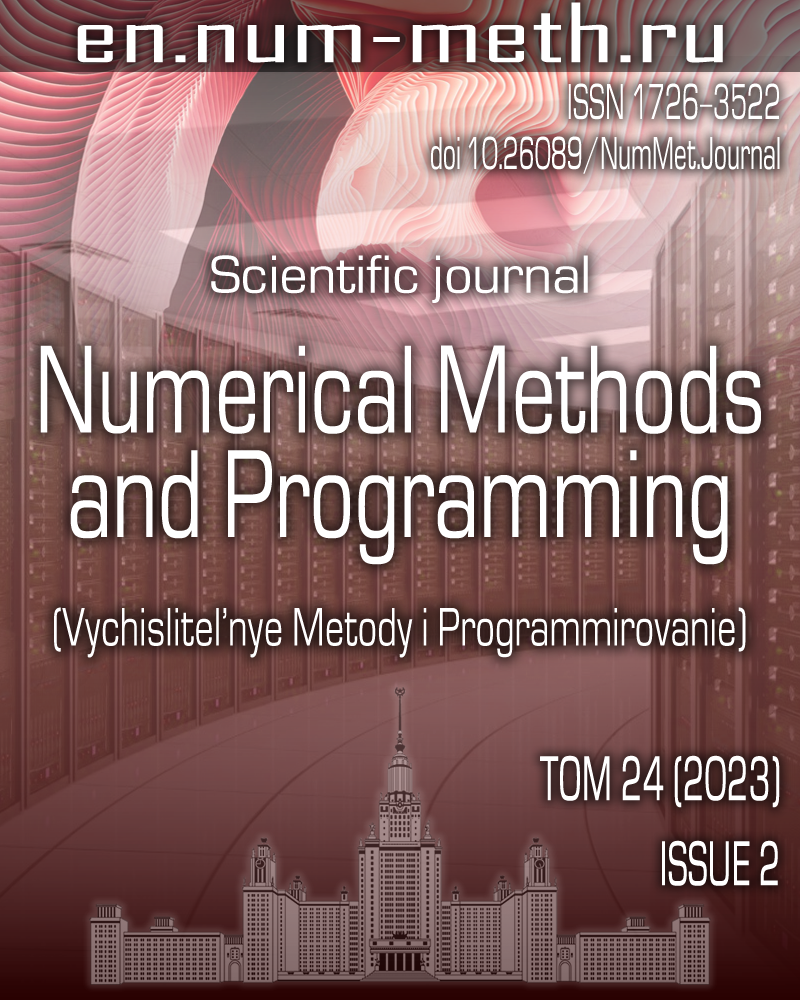DOI: https://doi.org/10.26089/NumMet.v24r209
A recurrent formula for calculating an impedance of the cathode catalyst layer in a polymer electrolyte fuel cell
Keywords:
Abstract
A recurrent formula for estimating an impedance of the cathode catalyst layer with fast oxygen transport in a polymer electrolyte fuel cell is derived. The catalyst layer is divided into N sub-layers and application of the charge conservation law enables to obtain the nonlinear recurrent relation Zn = f(Zn-1), where Zn is the accumulated impedance of all sub-layers up to the n-th one. Numerical solution of this relation gives the total impedance of the catalyst layer with taking into account variation of the static overpotential of the oxygen reduction reaction along the depth of this layer. The model is simple, robust and two orders of magnitude faster than the standard model based on numerical solution of the differential equation.
Published
Issue
Section
References
- A. Lasia, Electrochemical Impedance Spectroscopy and Its Applications (Springer, New York, 2014).
doi 10.1007/978-1-4614-8933-7. - Z. Tang, Q.-A. Huang, Y.-J. Wang, et al., “Recent Progress in the Use of Electrochemical Impedance Spectroscopy for the Measurement, Monitoring, Diagnosis and Optimization of Proton Exchange Membrane Fuel Cell Performance,” J. Power Sources 468, Article Number 228361 (2020).
doi 10.1016/j.jpowsour.2020.228361. - J. Huang, Y. Gao, J. Luo, et al., “Editors’ Choice--Review--Impedance Response of Porous Electrodes: Theoretical Framework, Physical Models and Applications,” J. Electrochem. Soc. 167, Article Number 166503 (2020).
doi 10.1149/1945-7111/abc655. - A. Kulikovsky and O. Shamardina, “A Model for PEM Fuel Cell Impedance: Oxygen Flow in the Channel Triggers Spatial and Frequency Oscillations of the Local Impedance,” J. Electrochem. Soc. 162 (9), F1068-F1077 (2015).
doi 10.1149/2.0911509jes. - A. A. Kulikovsky and M. Eikerling, “Analytical Solutions for Impedance of the Cathode Catalyst Layer in PEM Fuel Cell: Layer Parameters from Impedance Spectrum without Fitting,” J. Electroanal. Chem. 691, 13-17 (2013).
doi 10.1016/j.jelechem.2012.12.002. - A. A. Kulikovsky, “Analytical Solutions for Polarization Curve and Impedance of the Cathode Catalyst Layer with Fast Oxygen Transport in a PEM Fuel Cell,” J. Electrochem. Soc. 161 (8), E3171-E3179 (2014).
doi 10.1149/2.020408jes. - T. Schmitt, R. Bligny, G. Maranzana, and U. Sauter, “Rapid and Local EIS on a Segmented Fuel Cell: A New Method for Spatial and Temporal Resolution,” J. Electrochem. Soc. 169 (9), Article Number 094504 (2022).
doi 10.1149/1945-7111/ac9089. - A. Kulikovsky, “Analytical Impedance of PEM Fuel Cell Cathode Including Oxygen Transport in the Channel, Gas Diffusion and Catalyst Layers,” J. Electrochem. Soc. 169 (3), Article Number 034527 (2022).
doi 10.1149/1945-7111/ac5d97. - A. A. Kulikovsky, “The Regimes of Catalyst Layer Operation in a Fuel Cell,” Electrochim. Acta 55 (22), 6391-6401 (2010).
doi 10.1016/j.electacta.2010.06.053. - A. A. Kulikovsky, “A Physically-Based Analytical Polarization Curve of a PEM Fuel Cell,” J. Electrochem. Soc. 161 (3), F263-F270 (2014).
doi 10.1149/2.028403jes.
License
Copyright (c) 2023 А. А. Куликовский

This work is licensed under a Creative Commons Attribution 4.0 International License.


